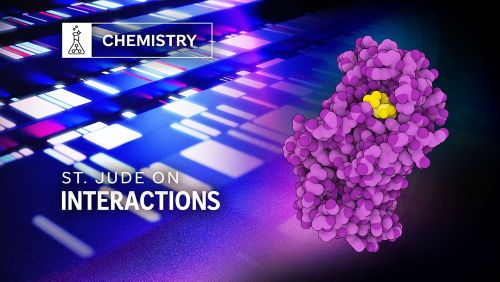St. Jude Family of Websites
Explore our cutting edge research, world-class patient care, career opportunities and more.
St. Jude Children's Research Hospital Home

- Fundraising
St. Jude Family of Websites
Explore our cutting edge research, world-class patient care, career opportunities and more.
St. Jude Children's Research Hospital Home

- Fundraising
Finding the balance between efficacy and toxicity in pediatric cancer treatment

An artistic rendering of pharmacogenomic information, paired with the structure of NUDT15, a protein that St. Jude researchers discovered affects sensitivity to a major pediatric cancer drug. Graphic by Briana Williams.
Cancer treatment balances on a razor’s edge. On one side, physicians must use enough of a drug to kill tumor cells effectively. On the other side, a high drug concentration can be harmful to a patient’s normal cells. In children, the difference between the two, called the therapeutic index, is small.
Despite that challenge, scientists have optimized treatment for the most common form of childhood cancer, acute lymphoblastic leukemia (ALL), curing over 90% of children treated in the United States. However, other childhood cancers still need new drugs to be treated effectively, and even ALL treatment could be improved to reduce long-term side effects. Unlike when ALL treatments were first devised, researchers are now awash in genetic information, enabling them to make connections between a patient’s genomic sequence and their likely response to therapy. This approach, pharmacogenomics, provides ways to predict and perfect the balance between beneficial and detrimental treatment regimens.
“Pharmacogenomics looks at how the differences in our genetic makeup influence the way we handle drugs and how we respond to them,” explained Jun J. Yang, PhD, Department of Pharmacy and Pharmaceutical Sciences. “We want to use this information to individualize therapy to maximize efficacy and minimize toxicity in childhood cancer treatment.”
In 2015, Yang uncovered a variant in a gene, NUDT15, which was associated with increased toxicity of mercaptopurine during pediatric ALL treatment, as published in Nature Genetics. Mercaptopurine is a chemotherapy drug necessary to cure ALL. However, in a subset of patients, it can lead to myelosuppression, a condition where patients cannot make enough blood cells. The researchers found that individuals with a specific NUDT15 variant were highly sensitive to mercaptopurine, so they could not tolerate a high dose, but could still be effectively treated with a smaller amount of the drug.
The discovery of the NUDT15 variant eventually led to a change to its Food and Drug Administration (FDA) label and altered global clinical guidelines for ALL treatment, marking the second time St. Jude pharmacogenomics led to a change in how mercaptopurine is used clinically.
Continuing a history of applied pharmacogenomics
St. Jude has a long history in pharmacogenomics, including work by Yang’s mentors, Mary Relling, PharmD, and William Evans, PharmD, both St. Jude emeritus faculty. They found differences in the gene TPMT that impacted mercaptopurine tolerance in pediatric ALL treatment. About 10% of patients were heterozygous for TPMT, having one functional and one nonfunctional version of the gene, though it was unclear how that impacted treatment. Having two dysfunctional genes was associated with high toxicity. The scientists uncovered that having even one dysfunctional TPMT gene increased mercaptopurine toxicity, necessitating frequent dose reduction clinically.
“TPMT became one of the first pharmacogenetic discoveries clinically implemented in the oncology world,” Yang said. “Fast forward to 2015, and we reported a second gene as important and as impressive as that first discovery made at St. Jude, and both changed the way that this drug is given globally. It shows how important studying and investing in pharmacogenomics can be.”
Genetic research has primarily focused on the pieces of DNA that encode genes; this is how Relling, Evans and Yang made their discoveries. However, that only accounts for about 2% of a human’s total DNA. The function of the other 98% was disregarded as unimportant for a long time, but more recent research shows that is not the case.
Decoding noncoding DNA
Scientists have identified single genes involved in treatment outcomes, but most associations between outcomes and DNA sequences appear to be related to noncoding regions and variants. Daniel Savic, PhD, Department of Pharmaceutical Sciences, has found noncoding DNA to be important in regulating the response to chemotherapy.
“It’s not always changes or mutations in the genes themselves, but when, where and at what level they are active, that impact how well you respond to chemotherapy,” Savic explained. “Noncoding DNA elements regulate cellular responses to ALL treatment through changes in this gene expression, so if you want to understand drug efficacy, you must examine these noncoding regions in DNA.”
However, researching these complicated noncoding genome interactions is more challenging than examining single genes. To address that complexity, Savic’s lab adopted high-throughput state-of-the-art massively parallel reporter screens and 3D mapping tools to find over 500 functional variants within noncoding DNA elements related to chemotherapy resistance. Published in Nature Communications, this technical feat for pediatric ALL treatment research also revealed important and novel genetic associations with clinical outcomes in patients.
“It was exciting to uncover so much functional noncoding variation linked to ALL chemotherapy response,” Savic said. “We anticipated that a small subset of these DNA sequence variants would be identified as significantly impacting gene expression, and were surprised to find such an extensive number across the noncoding genome. Fundamentally, this observation supports the important contribution of these noncoding elements to differences in treatment outcome among patients with ALL.”
The top variant his group discovered revealed a previously unknown resistance mechanism to the drug vincristine. When the researchers mutated or deleted the variant, cells were more sensitive to the drug, an effect they followed, revealing that the variant impacts the binding of a key protein within a noncoding element that controls the expression of a faraway gene involved in proliferation and translation of proteins, EIF3A. That distance was unexpected, as the enhancer element containing the variant did not regulate two genes that were much closer, instead using DNA’s 3D structure to “loop over” those genes to target EIF3A.
In a separate series of studies, published in Leukemia and Blood Advances, the scientists uncovered a novel mechanism underlying resistance to glucocorticoids, a set of steroid drugs essential to ALL treatment, also through changes in noncoding DNA elements. “We found an antagonism between glucocorticoid signaling and another pathway, canonical Wnt signaling,” Savic said. “Proteins from both bind to the same noncoding DNA elements across the genome, but with opposite effects. Wnt signaling promotes cell proliferation, and glucocorticoid signaling causes cell death because it’s a chemotherapeutic drug. We’re still trying to figure out how this happens mechanistically and how we may be able to use that knowledge to improve treatment.”
Though these cases show the power of pharmacogenomics, most drugs and genetic variants do not have such simple relationships with clinical outcomes, and new therapeutic interventions do not have data to fuel such analyses.
Sizing up a drug’s potential with pharmacokinetics
The first step of translating discoveries is identifying compounds, drugs or new molecular entities (NMEs) that “hit” the desired target(s). However, without historical data, scientists must assess a new intervention’s potential more directly at the chemical level in preclinical model systems, a far different process than pharmacogenomics analysis. As an example, if compounds do not reach targets at sufficient concentrations for an adequate time, they will not be effective. Alternatively, if they remain in the body for too long at excessive concentrations, they can be toxic.
Enter the discipline of pharmacokinetics.
Pharmacokinetics is the study of how the body acts on a drug, governing its absorption, distribution, metabolism and excretion. While pharmacogenomics often drives pharmacokinetic behavior, the latter must first be well-defined, which is rare for a new compound. Initial and ongoing understanding of a compound’s pharmacokinetics profile allows for pharmacogenomic discoveries; however, these may be years or even decades in the making.
The mercaptopurine story is instructive. It took many years to thoroughly understand the pharmacokinetics of the drug in children, which then enabled Relling and Evans to find pharmacogenomic correlates. In fact, the genetic variants of TPMT affect the cellular pharmacokinetics of 6-Mercaptopurine, leading to toxicity through elevated concentrations of the drug. Testing these features can estimate a new drug’s potential, as well as provide information for later pharmacogenomics analysis.
Burgess Freeman, PharmD, Center for Translational Pharmacology associate director, helps St. Jude investigators early in the process, guiding their new potential drug candidates through preclinical pharmacokinetics testing.
“We think about the whole process of how these compounds move through the body,” Freeman explained. “A drug is absorbed, distributed through the body, metabolized and then excreted. We test to see if enough is getting to the site of action to be effective. We can also use this information to estimate whether the agent will be tolerated in patients.”
A primary example of pharmacokinetics’ value can be found in attempts to develop novel therapies for brain tumors. Drugs to treat brain cancer must cross through the blood-brain barrier, a physical structure that separates the brain from the rest of the body for protection. Freeman’s group tests potential candidates, triaging out drugs with poor brain penetration. Such agents achieve lower target site concentrations and have a lower probability of success in the clinic. One example from Freeman’s work is the drug mirdametinib, which showed adequate brain penetration and an acceptable pharmacokinetics profile. This agent is now being tested in the SJ901 clinical trial for pediatric brain tumors.
Another use for pharmacokinetics is to study drugs that are repurposed from adults into the pediatric population, identifying correct dosages. “Biologically, children are not just little versions of adults,” Freeman explained. “Their bodies distinctly respond to drugs, with marked differences in the maturation of their enzymes, drug metabolism and body composition compared to adults.”
Balancing efficacy and toxicity in tandem
Pharmacogenomics and pharmacokinetics studies work together to balance efficacy and toxicity in pediatric cancer treatment, iteratively improving available anticancer drugs and, hopefully, pediatric cancer outcomes.
“We have a special responsibility to understand the balance between efficacy and toxicity in pediatric patients,” Yang said. “For adults, certain toxicities may not matter or have a large impact, such as infertility in older patients. But for children, who are still developing, their treatment could result in lifelong consequences. By understanding and predicting their personal response to a given therapeutic agent, we can give each child we treat their best chance at achieving a cure for their cancer, and a normal life afterwards.”






